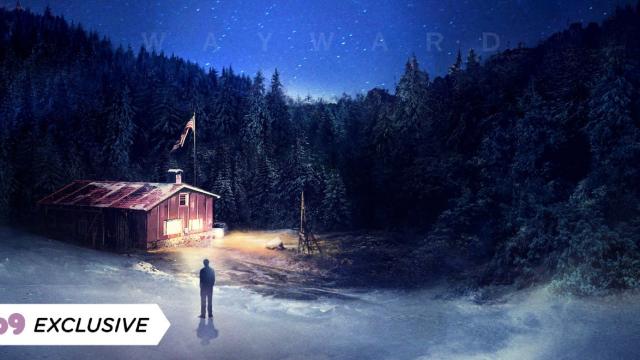Author Chuck Wendig is a favourite here at Gizmodo; we’ve featured excerpts from his books before, including his 2019 sci-fi smash hit Wanderers. Today we are thrilled to be debuting the cover and first excerpt from its follow-up, Wayward, which will be out next summer.
Here’s a synopsis of the book for starters:
Five years ago, ordinary Americans fell under the grip of a strange new malady that caused them to sleepwalk across the country to a destination only they knew. They were followed on their quest by the shepherds: friends and family who gave up everything to protect them.
Their secret destination: Ouray, a small town in Colorado that would become one of the last outposts of civilisation. Because the sleepwalking epidemic was only the first in a chain of events that led to the end of the world — and the birth of a new one.
The survivors, sleepwalkers and shepherds alike, have a dream of rebuilding human society. Among them are Benji, the scientist struggling through grief to lead the town; Marcy, the former police officer who wants only to look after the people she loves; and Shana, the teenage girl who became the first shepherd — and an unlikely hero whose courage will be needed again.
Because the people of Ouray are not the only survivors, and the world they are building is fragile. The forces of cruelty and brutality are amassing under the leadership of self-proclaimed president Ed Creel. And in the very heart of Ouray, the most powerful survivor of all is plotting its own vision for the new world: Black Swan, the A.I. who imagined the apocalypse.
Against these threats, Benji, Marcy, Shana, and the rest have only one hope: one another. Because the only way to survive the end of the world is together.
Here’s the full cover; the cover design is by Carlos Beltrán and David Stevenson, and the cover art is by Michael Bryan. After that, keep reading for the prologue to Wayward!

Atlas Haven
America City, Kansas
Now.
The President of the United States of America sat at his desk in a dim, octagonal room lit by lights in the floor. His desk was spare. It contained no books, for he was not a curious man. It contained no papers because what could he possibly have to sign now, after everything? There was a pen holder, a flat piece of wood with a soft trench where a single pen could neatly rest. A plaque detailed its history: the holder was a gift from British Prime Minister Declan Halvey and had been taken from the hull of the HMS Gannet, an anti-slaver ship from the British Navy.
In this way, the object matched the desk itself — known as the Resolute Desk, its own plaque explained some, if not all, of its history:
“H.M.S. ‘Resolute’, forming part of the expedition sent in search of Sir John Franklin in 1852, was abandoned in Latitude 74º 41′ N. Longitude 101º 22′ W. on 15th May 1854. She was discovered and extricated in September 1855, in Latitude 67º N. by Captain Buddington of the United States Whaler ‘George Henry’. The ship was purchased, fitted out and sent to England, as a gift to Her Majesty Queen Victoria by the President and People of the United States, as a token of goodwill & friendship. This table was made from her timbers when she was broken up, and is presented by the Queen of Great Britain & Ireland, to the President of the United States, as a memorial of the courtesy and loving kindness which dictated the offer of the gift of the ‘Resolute’.”
Parts of that history were missing, of course. Like how the ship had originally set out to discover the whereabouts of an entire missing Arctic expedition under the aforementioned Sir John Franklin, whose two ships were the aptly-named Erebus and the Terror. Or how the Resolute, along with three other vessels, became icebound themselves in that search, and that Sir Edward Belcher (a much-loathed individual with zero experience in Arctic expeditions) commanded the captains of those ships to abandon their vessels even though a coming thaw would’ve allowed those vessels to move again before too long. The embarrassment was heightened by the fact that, alongside losing their own ships, they failed to find the lost expedition. The plaque also did not mention how Captain Buddington had taken the ship under the rights of salvage, but the U.S. government intervened and used it as a goodwill gesture to soothe troubled relations with England.
And finally, it failed to mention that the Franklin expedition was found in 2014 — but neither by England nor the United States. It was in fact a Canadian effort that uncovered the missing sailors. They further discovered that the men under Franklin’s command suffered death by a variety of deficiencies and diseases — not to mention mental breakdowns, hypothermia, and ultimately, the eating-of-one-another. (Some of the men’s cold, mummified remains showed knife wounds and bite marks consistent with cannibalism.)
History was a chain, and many of the links were wet with blood.
As for the desk itself, well — It had been moved in and out of parts of the White House. Some presidents favoured its presence in the Oval; others relegated it to out-of-the-way rooms, either as a tourist attraction or a hidden curiosity. Some presidents modified it (Roosevelt added a panel to hide his braced legs from the world). Some presidents forgot about it, and others rediscovered it — though it was Jackie Kennedy, not John, who found the desk hidden in storage. Eisenhower used it for his radio broadcasts to the nation. Johnson didn’t care for it. Reagan reportedly adored it, and a replica sits in his presidential library. The first Bush kept it in the Oval for a handful of months, then retired it. But after that, it was used by every president since including Nora Hunt before she was assassinated during the White Mask pandemic of 2020.
The desk had become a vital emblem of the history and dignity of the office.
The man presently sitting at the desk didn’t give a shit about dignity. Dignity was all well and good, but what did it get you? Dignity was someone else’s idea of what you should be doing, how you should be acting. And history, in his view, was merely the road behind. Why look back? America was a series of errors cascading through its political machine, and studying those errors was both foolish and boring. Those errors were not Creel’s fault. Why scrutinize or apologise for them? Then you took ownership of those errors. And it was not on Creel to take responsibility for someone else’s fuck-ups.
When you walked up a set of steps, you didn’t turn around to look at the steps behind you. You were on your way up, not down. Those coming behind you did not deserve the help. If they wanted to be at the top of the steps, then it was on them to run, to climb, to ascend.
That’s what Creel did, every moment of every day.
He knew the way was to step up, up, up. On every step. On every head, on every back, and on everyone who offered to make themselves a plank for his ascent. Upward and onward. All in the name of power.
What mattered when he demanded this desk be brought from the White House here to Atlas Haven (what he jokingly called the Nuclear Winter White House to his inner circle) was not the desk’s history, but its present. Its present was as a symbol of his victory. Ed Creel had won. He had dominated the world. He had eliminated his rival, Hunt. He deserved this, and if now, at the end of the world, he could not occupy the real White House, he would take a part of it as a trophy.
The Resolute Desk was that trophy.
(Not that it mattered, now.)
Above the president, the air scrubbers made their air scrubber sound — a chatter, and then a hiss, a chatter, and then a hiss. Ch-ch-ch-ch-ch-ch-tsssss. Ch-ch-ch-ch-ch-ch-tsssss. His right hand lay flat against the desk and traced a curious pooling stain — a blood stain whose crimson wash made this part of the desk look like cherrywood and not the oak timbers of an old British ship.
Just then, the door to his “office” opened with a clang — the door was metal and thick, and a great wheel had to be operated to open it up. As the door drifted open, the man who entered turned to face the wall and put the flat of his broad, bratwurst-fingered hand against a panel. The room immediately brightened as the octagonal walls erupted in light — each was an LED screen that connected to the other, showing a single wrap-around vista of the Aquinnah Cliffs Overlook on Martha’s Vineyard — the sun-warmed blushing cliffs in one direction, the wind-churned Atlantic in the other.
But the illusion was corrupt: some pixels blinked, others were black and dead. One entire wall behind the desk had blue-screened, showing an error code as long as the Declaration of Independence. Even as the screens came on, they buzzed and clicked, as if electronic termites were chewing through digital walls.
“What do you want?” President Creel croaked.
The older man stepped forward — he was in a plush terrycloth robe, filthy at the edges. His cheeks were like boar jowls, his eyes set deep in the skull. This was Honus Clines. Vice President Honus Clines. Clines grinned — a big smile with small teeth in puffy pencil eraser gums. From behind his back he produced a Reebok shoebox wrapped with a simple red bow. “Go on,” he said, his soft Virginia accent evident in even those two small words. “Open it.”
Creel wanted to buck at the command, because even inside he roared, I do not take commands, not from my subordinates. And everyone was subordinate to him, so he didn’t take orders from anyone. Or so he told himself. It was a lie that echoed around his head so often and so loudly he almost believed it.
With a trembling hand, he undid the bow.
The ribbon fell away like a dead thing.
He stared at the box’s lid. And then at its margins. The bottom corner of the box was blackened with dry blood.
“Here, let me,” Clines said, and he popped the top of the box.
President Creel looked inside, and saw the block of clear epoxy, and in its centre, a leering, jeering eyeball. Frozen in its unswerving stare.
And at that, President Creel began to laugh — a small laugh at first that Clines felt compelled to join with his own shoulder-juggling chortles, but soon that laugh became a big belly laugh, a goddamn guffaw, and those heaving guffaws gave way to a series of hard coughs, and those hard coughs made Creel’s eyes wet with tears.
Or, at least, one of his eyes. The other would remain dry forever, it seemed, there in that box.
From the book Wayward by Chuck Wendig. Copyright © 2022 by Chuck Wendig.
Reprinted by arrangement with Del Rey Books, an imprint of Random House, a division of Penguin Random House LLC. All rights reserved.
Chuck Wendig’s Wayward will be released August 2, 2022; you can pre-order a copy here.
Wondering where our RSS feed went? You can pick the new up one here.
